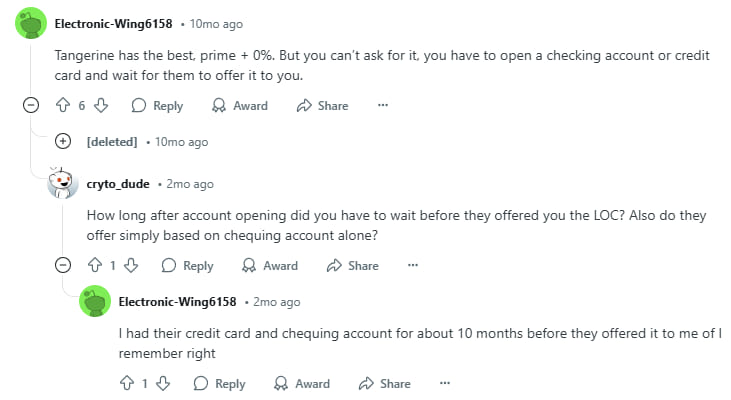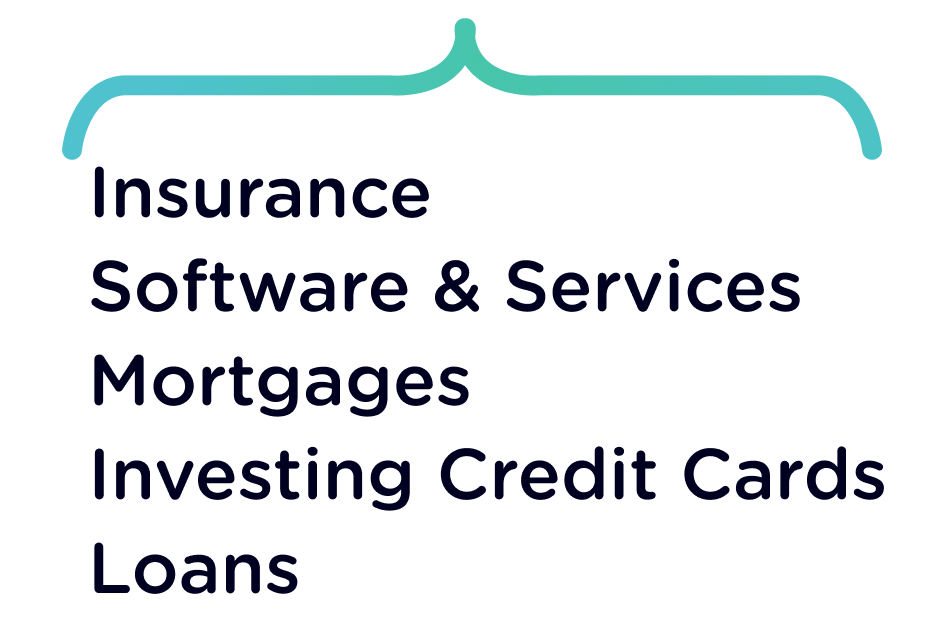A line of credit provides flexible access to funds, similar to a credit card, but typically with lower interest rates.
Whether you're consolidating balances, making a big purchase, or handling unexpected expenses, lines of credit provide a versatile, and often affordable, way to access funds when needed.
Best line of credit in Canada 2025 winner: Scotiabank Personal Line Of Credit
A Scotiabank Personal Line Of Credit is a revolving loan with lower interest rates than credit cards and convenient access to funds with flexible repayment options. Its credit limits range from $5,000 to $75,000, one of the widest in Canada.
- High maximum borrow amount
- Your Visa Access Card comes with perks
- Personal line of credit for students
- No online chat support service
- Difficult to find information about interest rates
- Can be easy to overspend
- Canadian citizen
- Employed
- Age of majority
- Special discounts on car rentals
- Provides a Visa Access Card for accessing funds
Our pick for Canada's best line of credit for 2025 is Scotiabank Personal Line Of Credit. With competitive interest rates and the ability to borrow and repay on your own terms, Scotiabank’s line of credit allows you to easily manage unexpected expenses, consolidate debt, or finance personal projects.
The plan has flexible repayment options and no prepayment penalties, so you can manage your debt on your schedule.
How we picked the best line of credit
To evaluate lines of credit, we analyze over 15 data points to generate a trustworthy Genius Rating. We consider all aspects of a line of credit, including credit limit range, APR, access to pre-approval, minimum credit score required, customer satisfaction, and how flexible the terms are, to assess its overall value. Then, the line of credit’s features are rated based on how they stack up against other available options.
Best line of credit for fixed rates: TD Personal Line Of Credit
A TD line of credit is a borrowing tool that gives you easy access like a credit card, but often with a much lower interest rate. Because it's a revolving credit product, you'll be given up to a $50,000 credit limit which you can spend, pay off, and spend again. This convenience makes it a popular choice for debt consolidation, plus you can decide how much you can pay off each month, as long as you meet the minimum.
- Borrow between $5,000 to $50,000
- Easy to access funds (including an access card)
- No registration fee
- Both fixed rate and variable rate options available
- Easy to apply
- Might not get the best interest rates around
- Using your TD access card might involve fees
- Connecting to your debit card may make it too easy to access
- Canadian citizen
- Employed
- Age of majority
- Fixed and variable rates available
- Multiple access options
If you prefer not to ride the potential rollercoaster of a variable interest rate, TD Personal Line Of Credit gives you the option to choose a more stable fixed rate to allow for more thorough financial planning. Or, you could get on the coaster with a competitive variable rate. They also offer plenty of ways to access your funds, including access cards and online banking.
This line of credit has a hefty maximum borrow amount of $50,000, perfect for a renovation or debt consolidation. If you need a higher borrow amount, the Scotiabank Personal Line Of Credit goes up to $75,000 – but it has no fixed rate options, so interest will vary.
Best line of credit with insurance: RBC Personal Line Of Credit
An unsecured line of credit can give you flexibility to deal with any current or future financial needs. Whatever your plans may be, an RBC Personal Line Of Credit is a solid choice. With a minimum of $5,000 and no stated maximum, RBC's offering can be more flexible than offers from other banks.
- Standard minimum limit of $5,000
- Upper limit of 65% of your home’s value
- Multiple ways to access your cash
- Flexible repayment options
- No fee to withdraw funds
- No access card mentioned
- Variable interest may mean higher rates later
- Only 2 free cheques a month
- Canadian citizen
- Employed
- Age of majority
- Optional LoanProtector life and disability or critical illness insurance available
The RBC Personal Line Of Credit offers an optional LoanProtector plan, which insures your loan in the case you become critically injured or ill and can no longer work.
It also features flexible repayment options and no fees for withdrawing funds, which make it an incredibly versatile loan.
What is a line of credit in Canada?
In Canada, lines of credit provide revolving credit, much like credit cards. When you open a line of credit, you're given a set limit and can borrow up to that amount—similar to how a credit card works—but with lower interest rates and no sneaky fees.
Here’s a quick rundown of what else you need to know about lines of credit in Canada:
- Lines of credit are more flexible than standard loans: Since you can use any amount you like (within your limit) and spend it on anything at all, a line of credit can be much more flexible than a standard loan.
- They have no repayment schedules: You can also pay back what you take out when you want, with no set repayment schedule.
- You only have to pay interest on the amount you borrow: In other words, you aren’t paying interest on the maximum credit limit, only the amount you use.
How does a line of credit work?
Unlike other loan types, lines of credit offer greater flexibility because you’re not restricted to spending the money on a specific purpose. You can use the funds for anything you need, whether it's for wedding expenses, home renovations, or consolidating debt.
The way you access the funds may vary depending on the financial institution, but most offer the following options:
- Transfer money to your chequing account
- Use cheques when making payments from the line of credit
- Withdraw money using a debit card at an ATM
- Pay a bill online or over the phone
Generally speaking, the more ways you can access your money the better.
Your lender will provide regular statements that outline the amounts you've withdrawn and the minimum payments you're required to make. The statement will also show how much credit you can access.
Types of lines of credit in Canada
There are several types of lines of credit available, with two main umbrella terms: unsecured and secured.
1. Secured line of credit
A secured line of credit is when the loan uses something else as collateral. This could be your home or another valuable asset.
Since the lender faces less risk with a secured line of credit, you’re more likely to be approved and typically benefit from lower interest rates.
2. Unsecured line of credit
An unsecured line of credit has no collateral. If you default on the loan, none of your possessions can be seized by the lender.
With that said, you'll likely see higher interest rates and harder acceptance rules for an unsecured line of credit.
3. Home equity line of credit (HELOC)
A HELOC is a specific type of secured loan that uses the equity in your home as collateral. It basically allows you to re-borrow the mortgage amount you've paid off as a line of credit.
As with any secured line of credit, a HELOC may offer lower interest rates. However, the risk of losing your home if you're unable to repay can be a significant downside.
4. Student line of credit
A student line of credit is a specialized credit option designed for students. It can be used to cover various expenses, including tuition, textbooks, or everyday costs like food and transportation.
Student lines of credit don't offer the same grace period after graduation as government student loans. With a student loan, you don't need to make payments for a set period after graduating, but a student line of credit requires you to start paying at least the interest on the amount borrowed.
Full repayments typically aren't required until 6 to 12 months after graduation, depending on the lender.
Line of credit interest rates in Canada
The Bank of Canada lists the average interest rate for secured and unsecured loans over five months.
Based on this data, the average line of credit interest rate in Canada is 9.53% for unsecured and 5.86% for secured.
| Type of line of credit | Unsecured | Secured |
|---|---|---|
| August 2024 | 10.07% | 6.39% |
| September 2024 | 9.84% | 6.23% |
| October 2024 | 9.46% | 5.73% |
| November 2024 | 9.41% | 5.65% |
| December 2024 | 8.85% | 5.28% |
For more information on the average line of credit rate, see: Interest rates charged for new and existing lending by chartered banks.
What line of credit interest rate should you expect?
One of the hardest parts about finding the right line of credit in Canada for you is comparing the available interest rates.
While it would make things much simpler if banks were transparent about their rates, very few actually post them (and if they do, it’s typically a range).
This is because line of credit interest rates depend on several factors, some of which are personal and others that can fluctuate frequently.
- Line of credit interest rates in Canada are usually variable, which means they rise and fall along with the prime rate in Canada. Right now, the prime rate in Canada is at 4.45%.
- The rate you get also depends on your credit score and credit history. You may get a better rate if you choose to go with a secured line of credit, especially if you have a relatively low credit score, but this does mean your collateral is at risk if you can't pay off your line of credit.
- The interest rate also depends on which financial institution. As a rule of thumb, online banks tend to offer lower rates, but they have harder-to-reach customer service (since they don't have physical locations you can walk into during business hours).
Line of credit calculator
Some of the major banks have line of credit calculators, including:
If you're looking to calculate your minimum monthly payment for your line of credit, the calculation would be outlined in the agreement you were sent when you opened an account.
Alternatives to a line of credit in Canada
Before you commit to a line of credit in Canada, it's usually beneficial to take a moment and reflect on the other options available for you.
Here's a closer look at the main line of credit alternatives.
Line of credit vs. credit card
Lines of credit:
| Pros | Cons |
|---|---|
|
|
Credit cards:
| Pros | Cons |
|---|---|
|
|
Line of credit vs. loan
Line of credit:
| Pros | Cons |
|---|---|
|
|
Loan:
| Pros | Cons |
|---|---|
|
|
How to know if a line of credit in Canada is right for you
Although these examples don’t address every detail or scenario, they highlight key factors to consider when deciding whether a line of credit is right for you:
Consider line of credit interest rates in Canada
It’s generally true that a line of credit has lower interest rates than a personal loan or credit card – a fact that could make or break your decision.
Student lines of credit often offer lower interest rates than traditional government student loans, but they also require you to pay the interest each month, even while in school. Not so with a student loan, which only requires students to start making payments after graduation.
Determine a comfortable payment frequency with your line of credit
One of the perks of a line of credit is the payment flexibility. You can choose to pay it off as you go, in monthly installments, or you can pay it all off at once.
If you work a commission-based job, are self-employed, work as a freelancer, or simply don't have a predictable income, then payment options like these can be helpful.
Decide between secured and unsecured line of credit options
At no point during the credit card application process do they ask if you’d like to use your sports car or boat as collateral.
Assets like this aren’t helpful to you if you want a credit card (unless you're looking at secured cards, of course, which require a security deposit).
But leveraging your car, boat, house, RV, or other valuable possessions can help secure you a line of credit with a far lower interest rate than a credit card.
Best line of credit according to Reddit
Most redditors agree that Tangerine has the best line of credit, at least in terms of its interest rate.
As of ten months ago, the interest rate was exactly equal to Canada’s prime rate, which is tough to beat. However, the current Tangerine website does mention there may be an additional adjustment factor to raise the interest rate, and you will need to be a Tangerine customer in order to gain access to their line of credit.
It’s also important to note that as an online bank, Tangerine’s customer service may be a bit more difficult to reach when compared to a big bank.
These barriers are confirmed on Reddit:

Others chime in with the solid (and time-consuming) advice to talk to several different banks and branches, which would allow you to see what the market is like and make a more informed choice. This is undoubtedly the best option for anyone who has enough patience to pull it off.
Editorial Disclaimer: The content here reflects the author's opinion alone, and is not endorsed or sponsored by a bank, credit card issuer, rewards program or other entity. For complete and updated product information please visit the product issuer's website.
FAQ
What is a line of credit?
A line of credit is a type of revolving loan, similar to a credit card. You only pay interest on the amount you take out and are only required to meet minimum payments every month.
How does a line of credit work?
When you spend money from a line of credit, you must make at least the minimum payment the following month. Once you pay it back, that portion of your credit is available again for you to take out as needed.
What's a home equity line of credit?
A home equity line of credit uses the part of your mortgage that you've already paid off to secure your loan. This usually means lower interest rates, but you risk losing your home if you default on the loan.
What's the difference between a line of credit vs. credit card?
While both give you access to revolving credit, the main difference is that credit card interest rates are far higher. On the other hand, credit cards can also earn rewards and offer easier access to your funds.
What's the difference between a line of credit and a loan?
One difference is that a loan is offered as a lump sum and you pay interest on the entire amount. In contrast, a line of credit is revolving and interest is charged only on what's used.
What are line of credit interest rates in Canada like?
At the time of writing, the average line of credit interest rates are 9.53% for unsecured and 5.86% for secured. The interest rate you get depends on several factors, including prime rate and your credit score.
Explore more loan products
Want to see more types of loan options? Here are some of the best rated products we've reviewed so far.



























